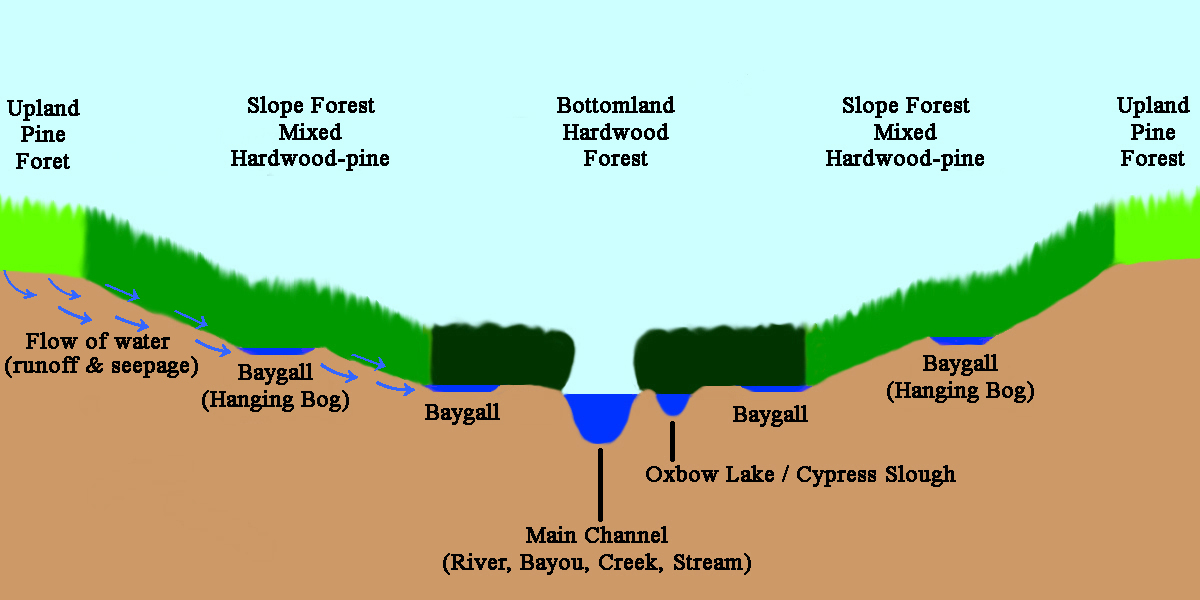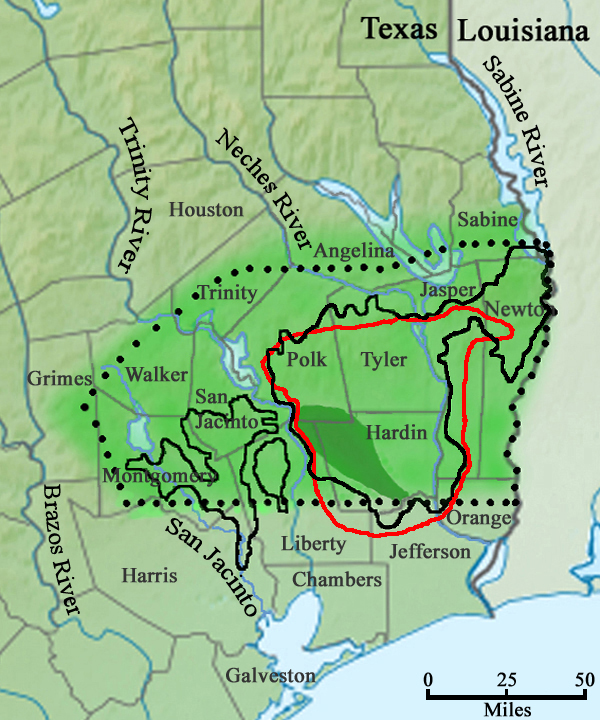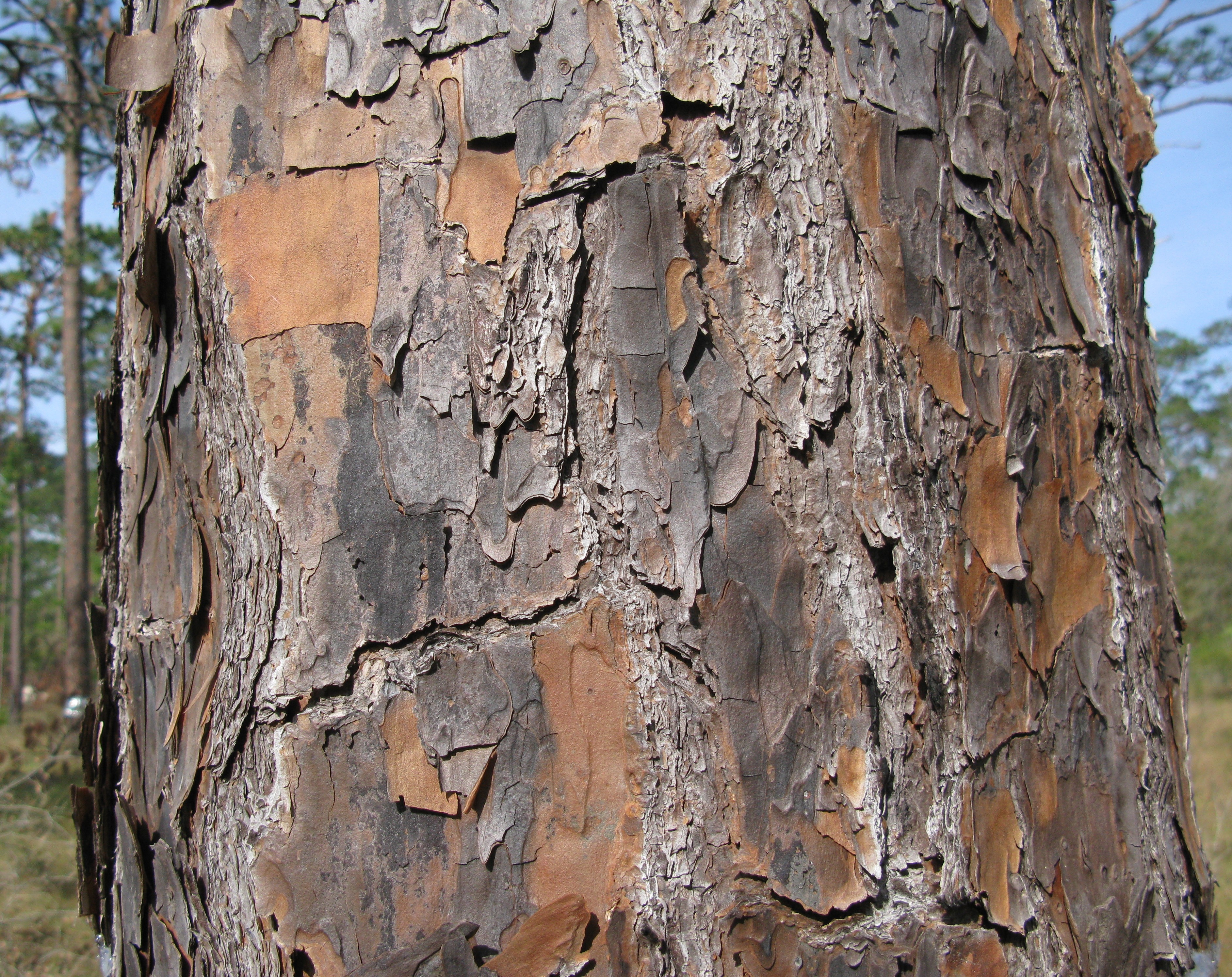|
Bayhead
A bayhead or baygall is a specific type of wetland or swamp habitat.Watson, Geraldine Ellis (2006) Big Thicket Plant Ecology: An Introduction, Third Edition (Temple Big Thicket Series #5). University of North Texas Press. 152 pp. Natural Communities of Louisiana:Bayhead Swamp/Forested Seep'. Louisiana Department of Wildlife and Fisheries. Retrieved 7 July 2020. The name ''baygall'' is derived from sweetbay magnolia (''Magnolia virginiana'') and sweet gallberry holly ('' Ilex coriacea'').Ajilvsgi, Geyata (1979) Wild Flowers of the Big Thicket: East Texas, and Western Louisiana. Texas A&M University Press. College Station, Texas 361 pp. Baygalls are recognized as a discrete ecosystem by ecologists and the swamps have been described as "distinct wetland communities in the Natural Communities of Louisiana". Baygall swamps are most often found in the low lying margins of floodplains and bottomlands with little or poor drainage to the main creek, bayou, or river channel. Baygall or bay ... [...More Info...] [...Related Items...] OR: [Wikipedia] [Google] [Baidu] |
Swamp
A swamp is a forested wetland.Keddy, P.A. 2010. Wetland Ecology: Principles and Conservation (2nd edition). Cambridge University Press, Cambridge, UK. 497 p. Swamps are considered to be transition zones because both land and water play a role in creating this environment. Swamps vary in size and are located all around the world. The water of a swamp may be fresh water, brackish water, or seawater. Freshwater swamps form along large rivers or lakes where they are critically dependent upon rainwater and seasonal flooding to maintain natural water level fluctuations.Hughes, F.M.R. (ed.). 2003. The Flooded Forest: Guidance for policy makers and river managers in Europe on the restoration of floodplain forests. FLOBAR2, Department of Geography, University of Cambridge, Cambridge, UK. 96 p. Saltwater swamps are found along tropical and subtropical coastlines. Some swamps have hammock (ecology), hammocks, or dry-land protrusions, covered by aquatic vegetation, or vegetation that tolerate ... [...More Info...] [...Related Items...] OR: [Wikipedia] [Google] [Baidu] |
Baygall
A bayhead or baygall is a specific type of wetland or swamp habitat.Watson, Geraldine Ellis (2006) Big Thicket Plant Ecology: An Introduction, Third Edition (Temple Big Thicket Series #5). University of North Texas Press. 152 pp. Natural Communities of Louisiana:Bayhead Swamp/Forested Seep'. Louisiana Department of Wildlife and Fisheries. Retrieved 7 July 2020. The name ''baygall'' is derived from sweetbay magnolia (''Magnolia virginiana'') and sweet gallberry holly (''Ilex coriacea'').Ajilvsgi, Geyata (1979) Wild Flowers of the Big Thicket: East Texas, and Western Louisiana. Texas A&M University Press. College Station, Texas 361 pp. Baygalls are recognized as a discrete ecosystem by ecologists and the swamps have been described as "distinct wetland communities in the Natural Communities of Louisiana". Baygall swamps are most often found in the low lying margins of floodplains and bottomlands with little or poor drainage to the main creek, bayou, or river channel. Baygall or bayh ... [...More Info...] [...Related Items...] OR: [Wikipedia] [Google] [Baidu] |
Big Thicket
The Big Thicket is the name given to a somewhat imprecise region of a heavily forested area of Southeast Texas in the United States. This area represents a portion of the mixed pine-hardwood forests or " Piney Woods" of the Southeast US. The National Park Service established the Big Thicket National Preserve (BTNP) within the region in 1974 and it is recognized as a biosphere reserve by UNESCO. Although the diversity of animals in the area is high for a temperate zone with over 500 vertebrates, it is the complex mosaic of ecosystems and plant diversity that is particularly remarkable. Biologists have identified at least eight, and up to eleven, ecosystems in the Big Thicket area. More than 160 species of trees and shrubs, 800 herbs and vines, and 340 types of grasses are known to occur in the Big Thicket, and estimates as high as over 1000 flowering plant species and 200 trees and shrubs have been made, plus ferns, carnivorous plants, and more. The Big Thicket has historically bee ... [...More Info...] [...Related Items...] OR: [Wikipedia] [Google] [Baidu] |
Blackwater River
A blackwater river is a type of River#Classification, river with a slow-moving channel flowing through forested swamps or wetlands. Most major blackwater rivers are in the Amazon Basin and the Southern United States. The term is used in fluvial studies, geology, geography, ecology, and biology. Not all dark rivers are blackwater in that technical sense. Some rivers in temperate regions, which drain or flow through areas of dark black loam, are simply black due to the color of the soil; these rivers are ''black mud rivers''. There are also black mud Estuary, estuaries. Blackwater rivers are lower in nutrients than Whitewater river (river type), whitewater rivers and have Ionic strength, ionic concentrations higher than rainwater. The unique conditions lead to flora and fauna that differ from both whitewater and Clearwater river (river type), clearwater rivers. The classification of Amazonian rivers into black, clear, and whitewater was first proposed by Alfred Russel Wallace in ... [...More Info...] [...Related Items...] OR: [Wikipedia] [Google] [Baidu] |
Big Thicket NP (6A) Jack Gore Baygall Unit, Hardin Co
Big or BIG may refer to: * Big, of great size or degree Film and television * ''Big'' (film), a 1988 fantasy-comedy film starring Tom Hanks * ''Big'', a 2023 Taiwanese children's film starring Van Fan and Chie Tanaka * ''Big!'', a Discovery Channel television show * ''Richard Hammond's Big'', a television show presented by Richard Hammond * ''Big'' (TV series), a 2012 South Korean TV series * "Big" (''My Hero''), a 2003 television episode * ''Banana Island Ghost'', a 2017 fantasy action comedy film Music * '' Big: the musical'', a 1996 musical based on the film * Big Records, a record label * ''Big!'' (Betty Who album) * ''Big'' (album), a 2007 album by Macy Gray * "Big" (Brassmunk song) * "Big" (Dead Letter Circus song) * "Big" (Fontaines D.C. song) * "Big" (Juice Wrld song) * "Big" (Sneaky Sound System song) * "Big" (Rita Ora and Imanbek song) * "Big" (Young M.A song) * "Big", a 1990 song by New Fast Automatic Daffodils * "Big", a 2021 song by Jade Eagleson from ... [...More Info...] [...Related Items...] OR: [Wikipedia] [Google] [Baidu] |
Pinus Palustris
The longleaf pine (''Pinus palustris'') is a pine species native to the Southeastern United States, found along the coastal plain from East Texas to southern Virginia, extending into northern and central Florida. In this area it is also known as "yellow pine" or "long leaf yellow pine", although it is properly just one out of a number of species termed yellow pine. It reaches a height of and a diameter of . In the past, before extensive logging, they reportedly grew to with a diameter of . The tree is a cultural symbol of the Southern United States, being the official state tree of Alabama. This particular species is one of the eight pine tree species that falls under the "Pine" designation as the state tree of North Carolina. Description The bark is thick, reddish-brown, and scaly. The leaves are dark green and needle-like, and occur in bundles of mainly three, sometimes two or four, especially in seedlings. They often are twisted and in length. A local race of ''P. palu ... [...More Info...] [...Related Items...] OR: [Wikipedia] [Google] [Baidu] |
Alnus Serrulata
''Alnus serrulata'', the hazel alder or smooth alder, is a thicket-forming shrub in the family Betulaceae. It is native to eastern North America and can be found from western Nova Scotia and southern New Brunswick south to Florida and Texas. Description ''Alnus serrulata'' is a large shrub or small tree that may grow up to high and in diameter. The scientific name originates from alnus which is an old name for alder; serrulata points to the finely-toothed leaf margins which it possesses. It takes about 10 yrs to mature. The plant prefers moist soil near streams, pond margins, and riversides. It usually has multiple stems from its base and reddish-green flowers. The broad, flat, dark green leaves are about 2 to 4 inches long. Leaf: The simple, round leaves are obovate, 2 to 5 in long, 1.2 to 2.8 in wide, obtuse, wider at middle, and V-shaped base. Veins are pinnate and conspicuous. Leaves have a smooth texture above and hairy texture below. The upper side of the leaves are dar ... [...More Info...] [...Related Items...] OR: [Wikipedia] [Google] [Baidu] |
Cyrilla Racemiflora
''Cyrilla racemiflora'', the sole species in the genus ''Cyrilla'', is a flowering plant in the family Cyrillaceae, native to warm temperate to tropical regions of the Americas, from the southeastern United States (coastal areas from southeastern Texas east to southeastern Virginia), south through the Caribbean, Mexico (Oaxaca only) and Central America to northern Brazil and Venezuela in South America. Common names include swamp cyrilla, swamp titi, palo colorado, red titi, black titi, white titi, leatherwood, ironwood, he-huckleberry, and myrtle. Habitat Can be found in rainforests, swamps, along streams, bogs, bayheads, backwaters, wet prairies, low pinelands, pocosins, flatwood depressions, preferring acidic, sandy, or peaty soils. Description In tropical rainforests, it is a large tree growing to or more tall and greater than in diameter, but only a shrub to tall in temperate regions at the northern edge of its range. It is most recognizable from its white flowers which ar ... [...More Info...] [...Related Items...] OR: [Wikipedia] [Google] [Baidu] |
Itea Virginica
''Itea virginica'', commonly known as Virginia willow or Virginia sweetspire, is a small North American flowering shrub that grows in low-lying woods and wetland margins. Virginia willow is a member of the Iteaceae family, and native to the southeast United States. ''Itea virginica'' has small flowers on pendulous racemes. Depending on location, the species will bloom in late spring to early summer. It prefers moist rich soil, but it can tolerate a wide range of soil types. When Virginia willow is used in horticulture it can form large colonies and may form dense root suckers, making the shrub hard to remove. Description ''Itea virginica'' is a deciduous shrub that grows to tall and broad, with alternate, simple leaves on arching stems. The plant's white or cream flowers bloom in summer, borne in downward-pointing, slightly curved spikes. It is a multi-stemmed, suckering and colonizing plant, with the stems branching infrequently except at the tops. In favorable conditions it ... [...More Info...] [...Related Items...] OR: [Wikipedia] [Google] [Baidu] |
Ilex Opaca
''Ilex opaca'', the American holly, is a species of holly, native to the eastern and south-central United States, from coastal Massachusetts south to central Florida, and west to southeastern Missouri and eastern Texas. Description ''Ilex opaca'' is a medium-sized broadleaved evergreen tree growing on average to wide, and up to tall. Typically, its trunk diameter reaches , sometimes up to . The bark is light gray, roughened by small warty lumps. The branchlets are stout, green at first and covered with rusty down, later smooth and brown. The winter buds are brown, short, obtuse or acute. The branches are short and slender. The roots are thick and fleshy. The leaves are alternate, long and wide, stiff, yellow green and dull matte to sub-shiny above (distinctly less glossy than the otherwise fairly similar European holly, '' Ilex aquifolium)'',Huxley, A., ed. (1992). ''New RHS Dictionary of Gardening''. Macmillan . often pale yellow beneath; the edges are curved into several ... [...More Info...] [...Related Items...] OR: [Wikipedia] [Google] [Baidu] |
Quercus Nigra
''Quercus nigra'', the water oak, is an oak in the red oak group (''Quercus'' sect. ''Lobatae''), native to the eastern and south-central United States, found in all the coastal states from New Jersey to Texas, and inland as far as Oklahoma, Kentucky, and southern Missouri. It occurs in lowlands and up to in elevation. Other names include spotted oak, duck oak, punk oak, orange oak, and possum oak. Description ''Quercus nigra'' is a medium-sized deciduous tree, growing up to tall with a trunk up to in diameter. Young trees have a smooth, brown bark that becomes gray-black with rough scaly ridges as the tree matures. The leaves are alternate, simple and tardily deciduous, remaining on the tree until mid-winter; they are long and broad, variable in shape, most commonly shaped like a spatula being broad and rounded at the top and narrow and wedged at the base. The margins vary, usually being smooth to shallowly lobed, with a bristle at the apex and lobe tips. The tree is easy ... [...More Info...] [...Related Items...] OR: [Wikipedia] [Google] [Baidu] |





